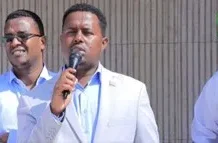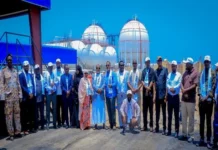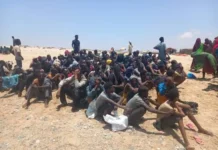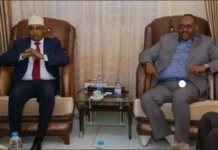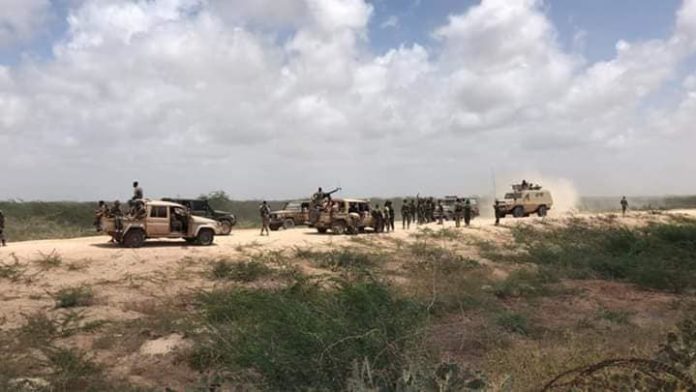When the Islamic terrorist group al Shabab displayed the gruesome, bloodied corpses of Somali National Army soldiers alongside its flag a week ago, its intent was clear: to intimidate and control.
U.S. Africa Command had a message as well and launched its 30th MQ-9 Reaper strike of the year in Somalia, killing one of the terrorists responsible.
In all, some 60 al Shabab fighters have been killed by U.S. airstrikes, according to an estimate compiled by the Washington Examiner as of Friday based on press releases from AFRICOM.
But the frequent use of airstrikes prompts questions as to whether they are contributing to stability in Somalia and the national security of the United States.
“Strikes are a way to remove imminent threats. Beyond that, it’s really to enable a government to return to an area they haven’t controlled,” said Judd Devermont, the Center for Strategic and International Studies’s Africa program director and a former national intelligence officer for Africa.
“It seems like the pace of the strikes is disproportionate to the ability of the Somali government to backfill,” he told the Washington Examiner. “There isn’t a lot of visibility on every attack and why that strike occurred. But that’s the key question: What is the strategic benefit of those strikes?”
In the early morning hours of Jan. 5, al Shabab fighters overran an airbase in Manda Bay, across the Somali border in Kenya.
For an hour, they battled Kenyan forces, firing rocket-propelled grenades at aircraft and vehicles. Ultimately, they also killed three Americans, two pilots and an air traffic controller, who were stationed at the base.
“Al Shabab is the most capable of the terrorist organizations on the African continent right now,” a senior defense official told the Washington Examiner in a phone interview from AFRICOM headquarters at Kelley Barracks in Stuttgart, Germany.
“We assess without the constant pressure that we’re putting on the network, that their continued development of their external operations capability would be the biggest threat to the United States homeland,” he said. “They continue to talk about wanting to kill Americans wherever they are.”
U.S. Africa Command is America’s youngest global combatant command, stood up in 2007, with a responsibility to assure U.S. interests across the continent. Today, its 5,200 Defense Department personnel are spread across 54 countries, including 650 to 800 in Somalia at any given time.
Its operating budget, now under review by the secretary of defense, is $453 million, not counting the costs of operations conducted by component commands.
“We’re continually trying to build our partner capacity to be able to deal with that terrorist threat to their country as a threat to the stability of their nation,” the defense official said. “Several countries are dealing in a big way with violent extremist organizations or the terrorist threats that are in the regions in the north of Africa and the east part of Africa as well as in the west.”
In an interview with the State Department’s Africa Bureau, the Washington Examiner inquired about the progress of efforts to stabilize Somalia, which is often touted as a success story.
“You have to look at it from the standpoint of where the situation stood in 2007, when the African Union Mission in Somalia originally deployed,” a State Department official told the Washington Examiner.
“AMISOM was in command of roughly 16 city blocks within Mogadishu,” he said. “Today, Shabab has been driven out of pretty much all major population centers. That’s not to discount the fact that Shabab remains a very potent threat.”
Devermont said the country had come a long way since the collapse of the state in 1991, when al Shabab controlled most of southern and south central Somalia.
“You can look at that and see that the state has been inching away from collapse over the last 10 years,” he said. “That doesn’t mean that al Shabab does not continue to remain a threat. It still controls territory in the rural areas, it clearly is able to operate in Mogadishu.”
As of November 2019, the U.S. has provided approximately $1.3 billion in support to AMISOM and $540 million in security assistance to build the capacity of the Somali Ministry of Defense and the Somali National Army.
Asymmetric attacks remain a lethal challenge, the State Department acknowledged, while the Defense Department repeats a common refrain in its unmanned aerial vehicle strike press releases: “Stability in Somalia will not be achieved through purely military means.”
“What people have to recognize is the persistent and relentless pressure on al Shabab is necessary to contain the threat,” Air Force Col. Chris Karns, public affairs officer for AFRICOM commander Gen. Stephen Townsend, told the Washington Examiner on the sidelines of congressional testimony in March.
“When you look at al Shabab, this is a group who has the ambition and the intent to one day strike the U.S. homeland. However, because of the relentless pressure, it’s not able to be organized enough or capable enough,” he said.
Karns said U.S. strikes made sure the threat did not grow and expand and that they created opportunity for the extended reach of governance.
“It helps create security and stability to enable some of the economic development to occur,” he said. “Tangible progress has been made across the whole of government in Somalia, but the progress is fragile.”
Devermont said the fight against terrorism in Somalia was a multidecade approach in conjunction with international partners. Stability provided by AFRICOM is both vital and relevant in the global great power competition in which the U.S. is engaged.
“Ultimately, if DOD decides to withdraw, it is going to create an opening for our adversaries to make hay and score points at our departure,” he said.
Devermont said adversaries such as China, which also conducts military training on the continent, could underscore the lack of U.S. reliability. Likewise, Russia could act asymmetrically through its security contractors.
Nonetheless, Somalia’s growing pains frustrate DOD policymakers, who must decide how best to orient the defense budget to be more in line with the 2018 National Defense Strategy and great power competition.
Problems include spats between the member states and the federal government. Sometimes, Devermont said, disparate security services at the local and national levels have “struggled to put together a coherent plan.”
A major milestone comes later this year, when Somalia could hold its first universal-voting election in 50 years. Devermont said the security actions taking place in Somalia now must be building toward creating the stability to host elections when the eyes of the world are watching.
“All these security operations have to be taken in the context of if we have a major election,” he said. “For the future, how does all this sort of come together?”




